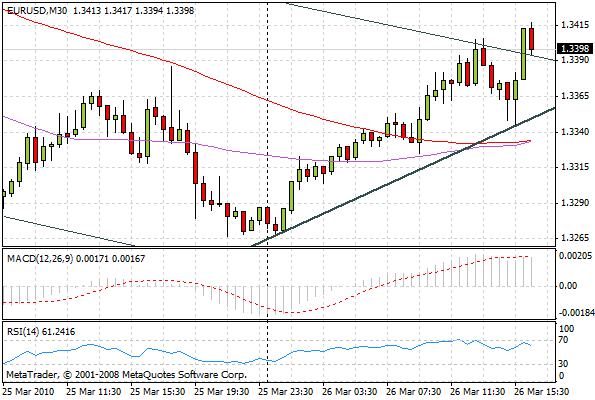Forex Market Review by Finexo.com
Past Events
• USD Unemployment Claims, out at 442K versus expected 452K, prior 456K (revised)
• USD Fed Chair Ben Bernanke Testified
• GBP Retail Sales, out at 2.1% versus expected 0.8%, prior -3.0% (revised)
• EUR EU Economic Summit, Day One
Upcoming Events
• EUR EU Economic Summit Day Two
Market Commentary
In the US first time jobless claims fell to the lowest level in six weeks as the rebound in the U.S. economy encourages companies to make fewer cuts in payrolls.
First-time jobless applications declined 14,000 in the week ended March 20 to 442,000, lower than anticipated according to Labor Department figures published yesterday. The number of people receiving unemployment insurance decreased, and those getting extended benefits also fell.
Employers are slowing the pace of payroll reductions, indicating budding optimism in an economy that’s been lifted by a pickup in manufacturing and expansion overseas. Companies now need to move beyond jobs cuts and start hiring to  ensure the recovery from the deepest recession since the 1930s is sustained.
ensure the recovery from the deepest recession since the 1930s is sustained.
President Barack Obama signed an $18 billion jobs bill into law on March 18th that provides a tax break to companies hiring unemployed workers, saying additional steps are needed to drive down unemployment. “There’s a lot more that we’re going to need to do to spur hiring in the private sector and bring about a full economic recovery,” Obama said.
The US Dollar which had reached a ten month high against the Euro on Wednesday fell back slightly yesterday as the Euro gained 0.43% to close at EUR 1.3329.
Elsewhere in the US, Federal Reserve Chairman Ben Bernanke yesterday said the U.S. economy still needs low interest rates and that the central bank will be ready to tighten credit “at the appropriate time.”
“The economy continues to require the support of accommodative monetary policies,” Bernanke said today in prepared testimony to the House Financial Services Committee, repeating parts of a statement to the panel from last month. “However, we have been working to ensure that we have the tools to reverse, at the appropriate time, the currently very high degree of monetary stimulus.”
The central bank chief and his colleagues have been outlining their strategy for tightening credit in time to prevent the recovery from stoking inflation. Officials are concerned that the federal funds rate, their main policy tool for 20 years, isn’t as effective as before in influencing borrowing costs.
“As the expansion matures, the Federal Reserve will need to begin to tighten monetary conditions to prevent the development of inflationary pressures,” Bernanke said in the text of remarks. “We have full confidence that, when the time comes, we will be ready to do so.”
Responding to questions, Bernanke said the “unemployment situation is very weak,” with 40% of those without jobs being out of work for a long time, and the housing market is “still quite weak.”
When Bernanke convened the Federal Open Market Committee for its March 16 meeting, policy makers left the benchmark federal funds rate in a range of zero to 0.25% and repeated a pledge to keep rates low for an “extended period.”
In the UK retail sales rebounded more than economists forecast in February with the biggest jump since May 2008 as Britons raised spending on goods from electrical items to auto fuel. Sales rose 2.1% from January, when they slumped by a more-than-previously-expected 3% in the longest cold snap for three decades. Excluding fuel, sales rose 1.6%, the most since June.
The increase in sales for February was led by an 11.2% jump at household goods stores, the statistics office said. Auto fuel sales rose by 9.1% and textile, clothing and footwear shops had a 1.1% gain. Food stores showed a 1.2% drop, the most since June 2008.
The January sales drop was revised down from a decline of 1.8% previously reported because of late returns of data from retailers, the statistics office said.
Next, the U.K.’s second-biggest clothing retailer said today full-year earnings rose 20% as it expanded Internet and catalog sales and sold more goods at full price in stores.
UK Chancellor of the Exchequer Alistair Darling, presenting his budget report to Parliament Wednesday said that to start cuts in public spending before the recovery was assured “would be both wrong and dangerous.” The ruling Labor Party’s resistance to faster spending cuts have helped it narrow the lead of the opposition Conservatives ahead of a general election due by June.
Jobless claims fell last month at the fastest pace since 1997, though the number of people in work in the three months through January dropped to a four-year low of 28.9 million.
The Pound continued to decline against the US Dollar yesterday. It fell 0.50% to close at GBP 1.4811. At also dropped 0.10% against the Euro closing the day at GBP 0.8960.
Yesterday was day one of the two day EU economic summit being held in Brussels. News has emerged that all 16 Euro Zone countries have backed a financing plan to help debt-laden Greece. The plan will also include assistance from the International Monetary Fund.
The safety net would total up to 22bn Euros. It would apply only if market lending to Greece dried up. Euro Zone nations would grant co-ordinated bilateral loans, totaling some two-thirds of the funding, French President Nicolas Sarkozy said.
Greek PM George Papandreou called it “a very satisfactory” move. The president of the European Council, Herman Van Rompuy, said the deal was significant “not just for Greece, but for the stability of the Euro Zone”. He added that the deal should tell markets to “have confidence that the Euro Zone will never abandon Greece”.
European Commission President Jose Manuel Barroso said he was “extremely happy that we’ve reached this deal”, calling it “a right decision”. The deal still needs to be backed by the rest of the 27-member EU. The Euro Zone had avoided seeking an IMF loan for Greece, preferring a European solution and anxious to maintain global confidence in the euro.
Chancellor Merkel has stressed the need to learn lessons from the crisis, saying that she wants a treaty change to allow sanctions to come into force should a Euro Zone country ever default on its debts. Mr. Papandreou urged EU leaders to act to stabilize the Euro.
The single currency hit a 10-month low against the US Dollar on Wednesday after a credit downgrade for Portugal, which is also struggling with heavy debts. The Euro reversed a three day slide against the US Dollar in trading yesterday, gaining 0.43% to close at EUR 1.3329.
Forex Market Review & Analysis by Finexo.com
Disclaimer: Trading the foreign exchange (Forex) carries a high level of risk, and may not be suitable for all investors.






